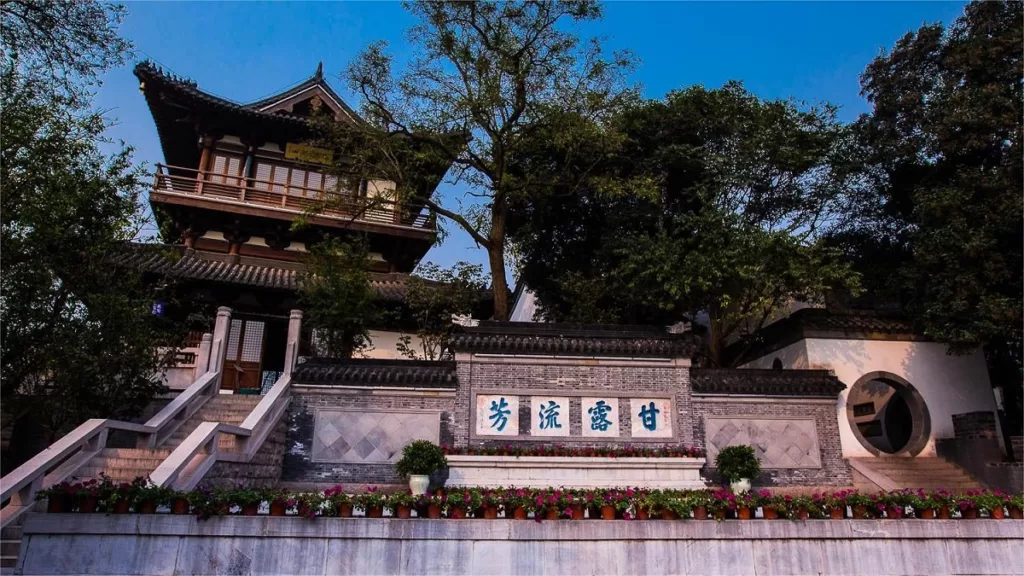Nestled in Beigu Mountain, Ganlu Temple (甘露寺), with its origins tracing back to the Three Kingdoms period, stands as a testament to China’s historical tapestry. Established in the first year of Ganlu during the Eastern Wu era (265 CE), the temple derived its name from this auspicious time. Through subsequent dynasties, Ganlu Temple underwent expansions and renovations, culminating in the impressive complex that we witness today.
Notably, the temple is immortalized in the 54th chapter of “Romance of the Three Kingdoms,” where it is referred to as the “Buddhist temple.” The narrative unfolds during the aftermath of the Battle of Red Cliffs in 209 CE when Liu Bei, reluctant to return Jingzhou to Eastern Wu, falls into a clever trap set by Sun Quan and Zhou Yu. Using Sun Shangxiang, Sun Quan’s sister, as bait, they lure Liu Bei to marry her in Jingkou, aiming to keep him and force the return of Jingzhou. Yet, Zhuge Liang‘s strategic brilliance prevails, and Liu Bei not only marries the beautiful Sun Shangxiang but also successfully returns to Jingzhou.
Ganlu Temple, perched on Beigu Mountain for centuries, has drawn countless scholars and poets who, inspired by the historic tales of the Three Kingdoms, have penned magnificent verses, capturing the essence of the landscape and the enduring spirit of the era.
Table of Contents
- Basic Information
- Location and Transportation
- Highlights of Ganlu Temple
- Vlog about Ganlu Temple
- Attractions near Ganlu Temple
Basic Information
| Estimated Length of Tour | 2 hours |
| Ticket Price | 30 RMB |
| Opening Hours | 8.00 – 17.30; Last admission: 16.30 |
| Telephone Number | 0086-0511-88812169 0086-0511-88858088 |
Location and Transportation
Ganlu Temple is located in the northern part of Zhenjiang, situated on the southern bank of the Yangtze River. The precise address is 3 Dongwu Road, Jingkou District, Zhenjiang City, Jiangsu Province.
To get there, tourists can take bus 4, 6, 8, 25, 49, 83, 112, 130, 133, 135, or 204 and get off at Ganlu Temple Stop (甘露寺站).
Highlights of Ganlu Temple
Iron Pagoda
Ganlu Temple is renowned worldwide for its Iron Pagoda, a nine-tiered, octagonal structure boasting exquisite craftsmanship. Originally built during the Song Dynasty, the pagoda suffered a partial collapse due to a tsunami in the Ming Dynasty, leaving only the bottom three levels. In 1960, during the restoration of the pagoda, the Zhenjiang Cultural Management Committee made a remarkable discovery at a depth of three and a half feet in the pagoda’s base – an underground chamber.
Within the hidden chamber of Ganlu Temple, a rectangular stone casket was found, containing numerous smaller stone caskets. The excavation revealed over 700 Buddhist relics, an unprecedented quantity. Among them, the most precious were 11 relics confirmed by scholars to be the cremated remains of Siddhartha Gautama housed in a gold coffin and silver urn within one of the stone caskets.
Trial Sword Stone
Adjacent to the Ganlu Temple lies the “Trial Sword Stone.” This massive, split rock, standing approximately 1.5 meters tall, holds a unique story. Legend has it that during the supposed marriage alliance between Sun Quan and Liu Bei, the two leaders visited the Fenghuang Pool. Liu Bei, noticing a large stone by the pool, took a sword from one of his attendants and silently prayed, “If I can safely return to Jingzhou and achieve the ambition of becoming a hegemon, let the stone split beneath my sword; if I am to die in this place, may the stone remain intact.” As he swung the sword, sparks flew, and the enormous stone cracked in response.
Linjiang Pavilion
Further west within Ganlu Temple, one encounters the Riverside Pavilion, known as the “Linjiang Pavilion.” According to legend, after the alliance between Sun and Liu families disintegrated, Lady Sun, following Liu Bei to Jingzhou, was deceived and forcibly detained in Jiangdong by Sun Quan. In the aftermath of the Battle of Yiling, hearing false rumors of Liu Bei’s death in Baidi City, Lady Sun, grief-stricken, climbed the Linjiang Pavilion. In this poignant setting, she made offerings while gazing westward before tragically taking her own life by plunging into the river. Consequently, the pavilion is also known as the “Sacrifice to the River Pavilion” in commemoration of this tragic event.





